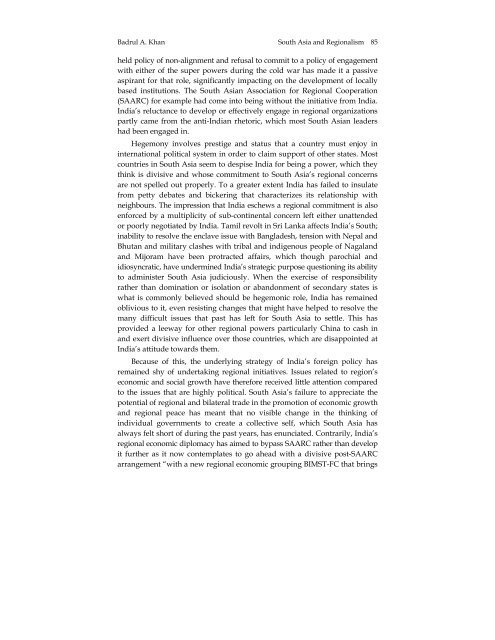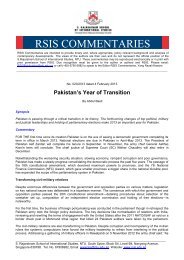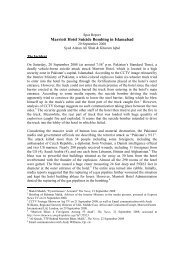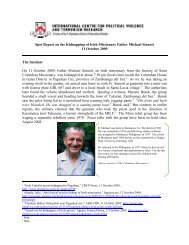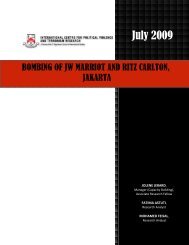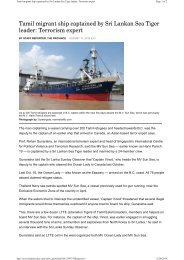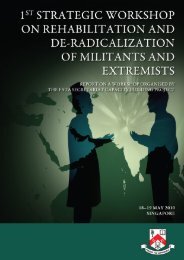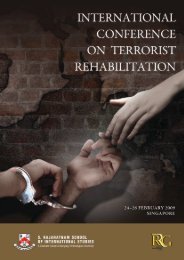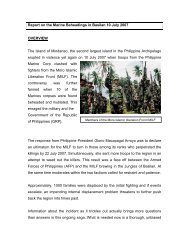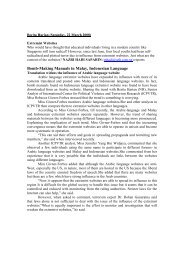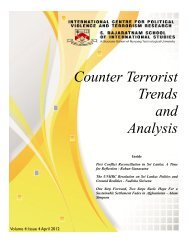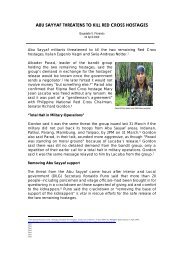Peace and Security Review, Vol.1 No. 2 - International Centre for ...
Peace and Security Review, Vol.1 No. 2 - International Centre for ...
Peace and Security Review, Vol.1 No. 2 - International Centre for ...
Create successful ePaper yourself
Turn your PDF publications into a flip-book with our unique Google optimized e-Paper software.
Badrul A. Khan South Asia <strong>and</strong> Regionalism 85<br />
held policy of non-alignment <strong>and</strong> refusal to commit to a policy of engagement<br />
with either of the super powers during the cold war has made it a passive<br />
aspirant <strong>for</strong> that role, significantly impacting on the development of locally<br />
based institutions. The South Asian Association <strong>for</strong> Regional Cooperation<br />
(SAARC) <strong>for</strong> example had come into being without the initiative from India.<br />
India’s reluctance to develop or effectively engage in regional organizations<br />
partly came from the anti-Indian rhetoric, which most South Asian leaders<br />
had been engaged in.<br />
Hegemony involves prestige <strong>and</strong> status that a country must enjoy in<br />
international political system in order to claim support of other states. Most<br />
countries in South Asia seem to despise India <strong>for</strong> being a power, which they<br />
think is divisive <strong>and</strong> whose commitment to South Asia’s regional concerns<br />
are not spelled out properly. To a greater extent India has failed to insulate<br />
from petty debates <strong>and</strong> bickering that characterizes its relationship with<br />
neighbours. The impression that India eschews a regional commitment is also<br />
en<strong>for</strong>ced by a multiplicity of sub-continental concern left either unattended<br />
or poorly negotiated by India. Tamil revolt in Sri Lanka affects India’s South;<br />
inability to resolve the enclave issue with Bangladesh, tension with Nepal <strong>and</strong><br />
Bhutan <strong>and</strong> military clashes with tribal <strong>and</strong> indigenous people of Nagal<strong>and</strong><br />
<strong>and</strong> Mijoram have been protracted affairs, which though parochial <strong>and</strong><br />
idiosyncratic, have undermined India’s strategic purpose questioning its ability<br />
to administer South Asia judiciously. When the exercise of responsibility<br />
rather than domination or isolation or ab<strong>and</strong>onment of secondary states is<br />
what is commonly believed should be hegemonic role, India has remained<br />
oblivious to it, even resisting changes that might have helped to resolve the<br />
many difficult issues that past has left <strong>for</strong> South Asia to settle. This has<br />
provided a leeway <strong>for</strong> other regional powers particularly China to cash in<br />
<strong>and</strong> exert divisive influence over those countries, which are disappointed at<br />
India’s attitude towards them.<br />
Because of this, the underlying strategy of India’s <strong>for</strong>eign policy has<br />
remained shy of undertaking regional initiatives. Issues related to region’s<br />
economic <strong>and</strong> social growth have there<strong>for</strong>e received little attention compared<br />
to the issues that are highly political. South Asia’s failure to appreciate the<br />
potential of regional <strong>and</strong> bilateral trade in the promotion of economic growth<br />
<strong>and</strong> regional peace has meant that no visible change in the thinking of<br />
individual governments to create a collective self, which South Asia has<br />
always felt short of during the past years, has enunciated. Contrarily, India’s<br />
regional economic diplomacy has aimed to bypass SAARC rather than develop<br />
it further as it now contemplates to go ahead with a divisive post-SAARC<br />
arrangement “with a new regional economic grouping BIMST-FC that brings<br />
<strong>Vol.1</strong>, <strong>No</strong>.2 2008 pp.77-93


